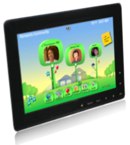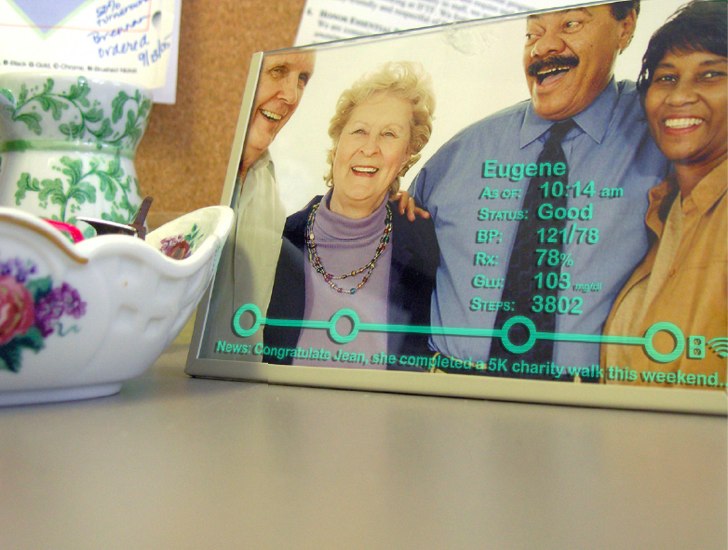Future Now
The IFTF Blog
Emotional Networking for Caring and Well-being
I just got a note in my email. My aunt is busy with her own appointment, and nobody had yet volunteered to pick my uncle up from the VA hospital tomorrow, after he recovers from surgery. Hey, it's a Friday. I can take off a little early to pick him up, and get him to my cousin's place over the hill. I respond to the email, volunteering.
In a grocery store across town, my aunt's phone chimes in her purse. On the tray attached to my uncle's hospital bed, a digital picture frame brightens, and my little bobble head avatar floats forward and let's him know he can expect me when it's time for him to check out.
I could live with this future. A couple years ago, the same arrangement would have taken at least a dozen stressed-out calls between my aunt and my mom, my mom and me, me and my five cousins, me and my aunt, and finally me at the VA with my mom, trying to find my uncle's room in the biggest dead-cell zone in the valley. At the end of the day, while everyone's relieved when the surgery goes well, everyone has a headache.
This streamlined future of ambient, collaborative caregiving isn't quite here yet, but today at IFTF we heard a fantastic talk from one of our neighbors, Emota.net. They're bringing this future to life. They've coined their discipline "emotional networking, which complements existing telehealth solutions to address not just clinical health, but emotional and social aspects of elder care." They're building a platform that can operate across numerous devices, and facilitate the convergence of multiple communications media to bring different generations together.
The

purpose is to distribute caregiving practices among a support network of family, friends and care professionals, while giving this network a tangible presence in a person's everyday environment. It takes "ambient co-presence" to a functional extreme, creating a gentle convergence of email, updating services, and virtual worlds. Image that you're hanging out on your grandma's kitchen table, tossing her hearts and flowers on a break while she reads your status updates (if she's so inclined). And she bobs around in an app on your desktop, or phone, or tablet. If she needs help, you'll get a notice, or if she's really sick, her nurse will get a notice. Otherwise, you're just there: framed on the table with her other family, friends, caregivers.
This all sounded awfully familiar.

Our artifacts from the future aren't product designs, they don't even necessarily represent futures we would want to live in. They're meant to provoke thought about the future they represent. Even so, sometimes it's pretty cool when they're spot-on. And as the slide popped up featuring a touch-screen picture frame of a caregiving network, my mind went straight to the networked aging artifact from our Global Health Economy Map.

Emota.net also covers so many strategies enumerated in From Caregiving to Caring: A New Approach to Civic Engagement by Jason Tester and Rachel Lyle Hatch, it's just surreal.
When asked how his product might interact with, say, Intel's Health Guide, Emota.net CEO Paul To responded, "We'd love to be their screensaver."
Paul contrasted their approach with the dozens of other aging-in-place telepresence efforts that are based on pushing information to elders, or facilitating transactions with clinical professionals. Their whole model--from the way that messages appear to the bobbing, cartoon-style world--is designed to be gentle and unobtrusive. For example, while they're not strictly a prescription compliance service, medication reminders and doctors appointment reminders can be programmed in. They don't pop up, though, like normal obnoxious calendar alerts. They're cartoon birds on a telephone wire in the distance, who gradually amble into the foreground. When the time is right, they bump in to the screen and give their message.

Paul explained that they wanted to program the guilt out of caregiving. I got that vibe loud and clear from the easy playfulness of their designs. However, I honestly don't know if a nonintrusive, "guilt-free, effortless way to express and fulfill desires and needs" is realistic. Eventually, would the amusing cuteness wear off, and the guilt return? The question was even raised whether wholly guilt-free was a good direction. Emotions motivate action, and guilt can be a strong motivator. Could designing to minimize guilt also backlash into people settling into complacency for smaller actions?
Well, sure. But this, like Groundcrew.us or The Extraordinaries, is based fundamentally on scaling caring actions. Lowering the barriers to entry from all sides (technological skill, time, effort, emotional burden) allows more people to be included in caring. The premise is that if more people engaged in small positive acts of volunteerism and caring, it can relieve the sometimes crushing burden of caregiving for the few.
An emotional network can become much more than the sum of its messages.
The story I told at the beginning of this post highlights some advantages of this system in a given instance, but I don't think that a single interaction captures the most important aspect of this platform. The benefit here is not only in smoothing over events, but in the cumulative benefit of social connection for older adults. Social isolation and depression have a huge impact on countless health issues, from frequent hospital readmissions to difficulty with healthy eating. Emota.net is working with the NSF, health systems, health ensurers and communities to refine ways this technology could enhance connection and emotional health. The need for this for elder care is great, but it's really a technology for strengthening connections between generations and age cohorts.
Ultimately, the goal is the same across generations: to increase our emotional intelligence. The easier it becomes for us to care, the better we can improve our collective well-being.



